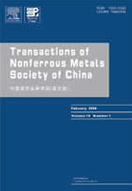Effect of nickel phosphide nanoparticles crystallization on hydrogen evolution reaction catalytic performance
(1. School of Materials Science and Engineering, Shanghai Jiao Tong University, Shanghai 200240, China;
2. State Key Laboratory of Metal Matrix Composites, Shanghai Jiao Tong University, Shanghai 200240, China;
3. School of Materials Science and Engineering, Tianjin University, Tianjin 300072, China;
4. Key Laboratory of Advanced Ceramics and Machining Technology (Ministry of Education), and Tianjin Key Laboratory of Composite and Functional Materials, Tianjin University, Tianjin 300072, China)
2. State Key Laboratory of Metal Matrix Composites, Shanghai Jiao Tong University, Shanghai 200240, China;
3. School of Materials Science and Engineering, Tianjin University, Tianjin 300072, China;
4. Key Laboratory of Advanced Ceramics and Machining Technology (Ministry of Education), and Tianjin Key Laboratory of Composite and Functional Materials, Tianjin University, Tianjin 300072, China)
Abstract: In order to investigate the effect of nickel phosphide nanoparticles’ (Ni-P NPs) crystallization on hydrogen evolution reaction (HER) catalytic performance, amorphous Ni-P NPs and crystalline Ni12P5 were synthesized by a simple and low-cost autocatalytic reduction method and heat treatment process. The result of electrochemical tests shows that crystalline Ni12P5 has much higher HER catalytic activity than the amorphous one. X-ray diffraction, transmission electron microscopy and X-ray photoelectron spectroscopy revealed that Ni-P bond formed during crystallization, making Ni positively charged and P negatively charged. This charged nature of Ni12P5 is similar to [NiFe] hydrogenase and its analogous, which make the removal of H2 less energy-cost.
Key words: hydrogen evolution reaction; nickel phosphide nanoparticles; Ni12P5; catalyst; crystallization

